2009 FORD MUSTANG tire pressure
[x] Cancel search: tire pressurePage 11 of 33
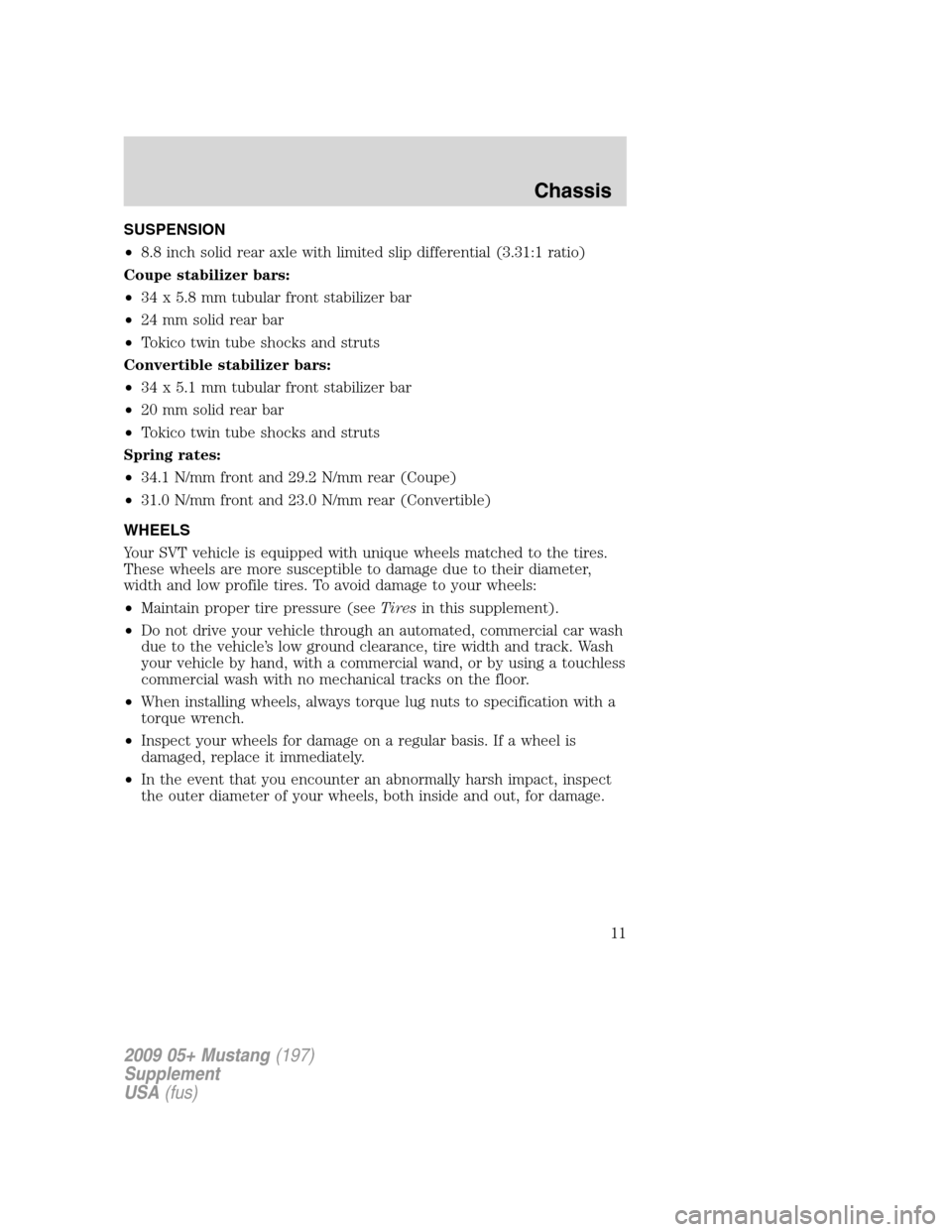
SUSPENSION
•8.8 inch solid rear axle with limited slip differential (3.31:1 ratio)
Coupe stabilizer bars:
•34 x 5.8 mm tubular front stabilizer bar
•24 mm solid rear bar
•Tokico twin tube shocks and struts
Convertible stabilizer bars:
•34 x 5.1 mm tubular front stabilizer bar
•20 mm solid rear bar
•Tokico twin tube shocks and struts
Spring rates:
•34.1 N/mm front and 29.2 N/mm rear (Coupe)
•31.0 N/mm front and 23.0 N/mm rear (Convertible)
WHEELS
Your SVT vehicle is equipped with unique wheels matched to the tires.
These wheels are more susceptible to damage due to their diameter,
width and low profile tires. To avoid damage to your wheels:
•Maintain proper tire pressure (seeTiresin this supplement).
•Do not drive your vehicle through an automated, commercial car wash
due to the vehicle’s low ground clearance, tire width and track. Wash
your vehicle by hand, with a commercial wand, or by using a touchless
commercial wash with no mechanical tracks on the floor.
•When installing wheels, always torque lug nuts to specification with a
torque wrench.
•Inspect your wheels for damage on a regular basis. If a wheel is
damaged, replace it immediately.
•In the event that you encounter an abnormally harsh impact, inspect
the outer diameter of your wheels, both inside and out, for damage.
2009 05+ Mustang(197)
Supplement
USA(fus)
Chassis
11
Page 12 of 33
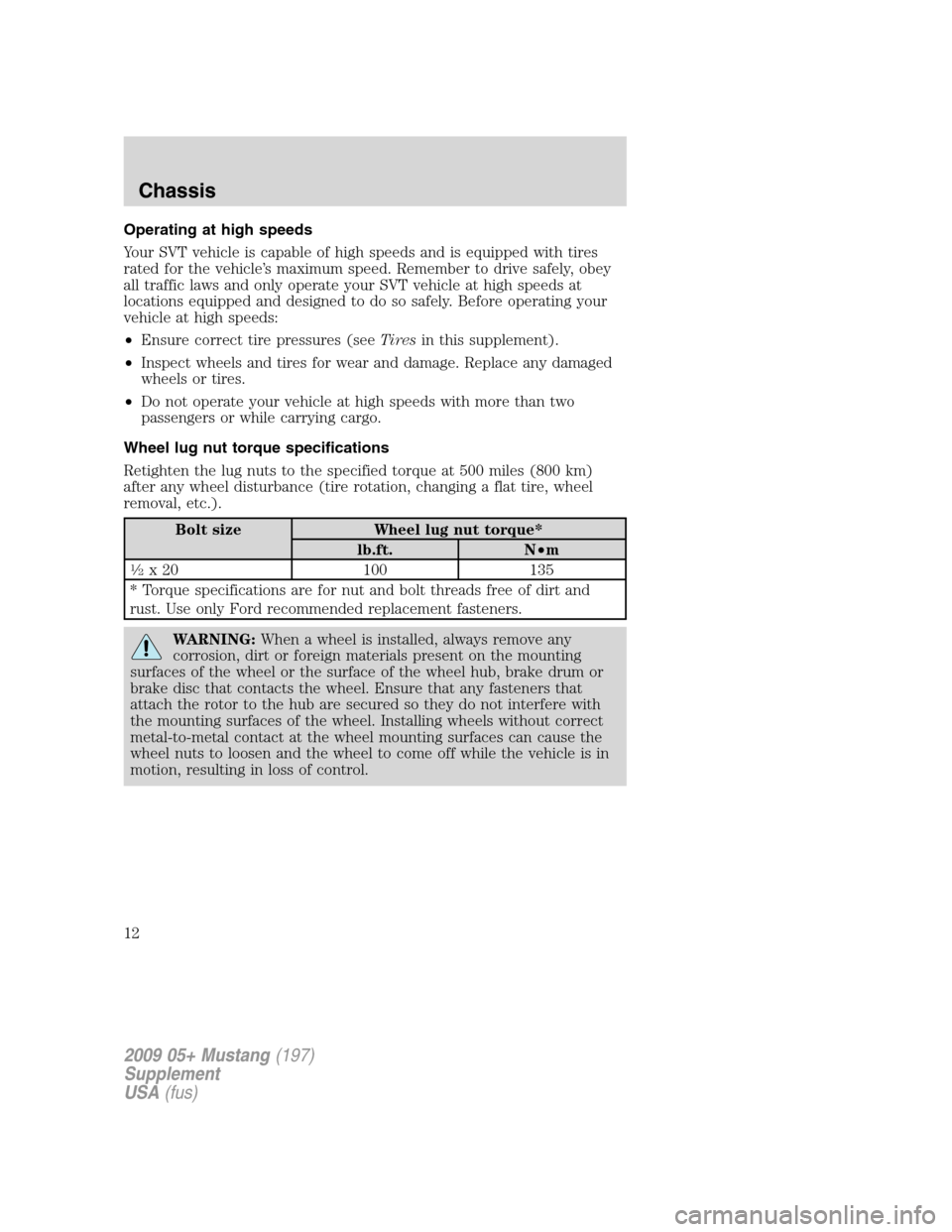
Operating at high speeds
Your SVT vehicle is capable of high speeds and is equipped with tires
rated for the vehicle’s maximum speed. Remember to drive safely, obey
all traffic laws and only operate your SVT vehicle at high speeds at
locations equipped and designed to do so safely. Before operating your
vehicle at high speeds:
•Ensure correct tire pressures (seeTiresin this supplement).
•Inspect wheels and tires for wear and damage. Replace any damaged
wheels or tires.
•Do not operate your vehicle at high speeds with more than two
passengers or while carrying cargo.
Wheel lug nut torque specifications
Retighten the lug nuts to the specified torque at 500 miles (800 km)
after any wheel disturbance (tire rotation, changing a flat tire, wheel
removal, etc.).
Bolt size Wheel lug nut torque*
lb.ft. N•m
1�2x 20 100 135
* Torque specifications are for nut and bolt threads free of dirt and
rust. Use only Ford recommended replacement fasteners.
WARNING:When a wheel is installed, always remove any
corrosion, dirt or foreign materials present on the mounting
surfaces of the wheel or the surface of the wheel hub, brake drum or
brake disc that contacts the wheel. Ensure that any fasteners that
attach the rotor to the hub are secured so they do not interfere with
the mounting surfaces of the wheel. Installing wheels without correct
metal-to-metal contact at the wheel mounting surfaces can cause the
wheel nuts to loosen and the wheel to come off while the vehicle is in
motion, resulting in loss of control.
2009 05+ Mustang(197)
Supplement
USA(fus)
Chassis
12
Page 13 of 33
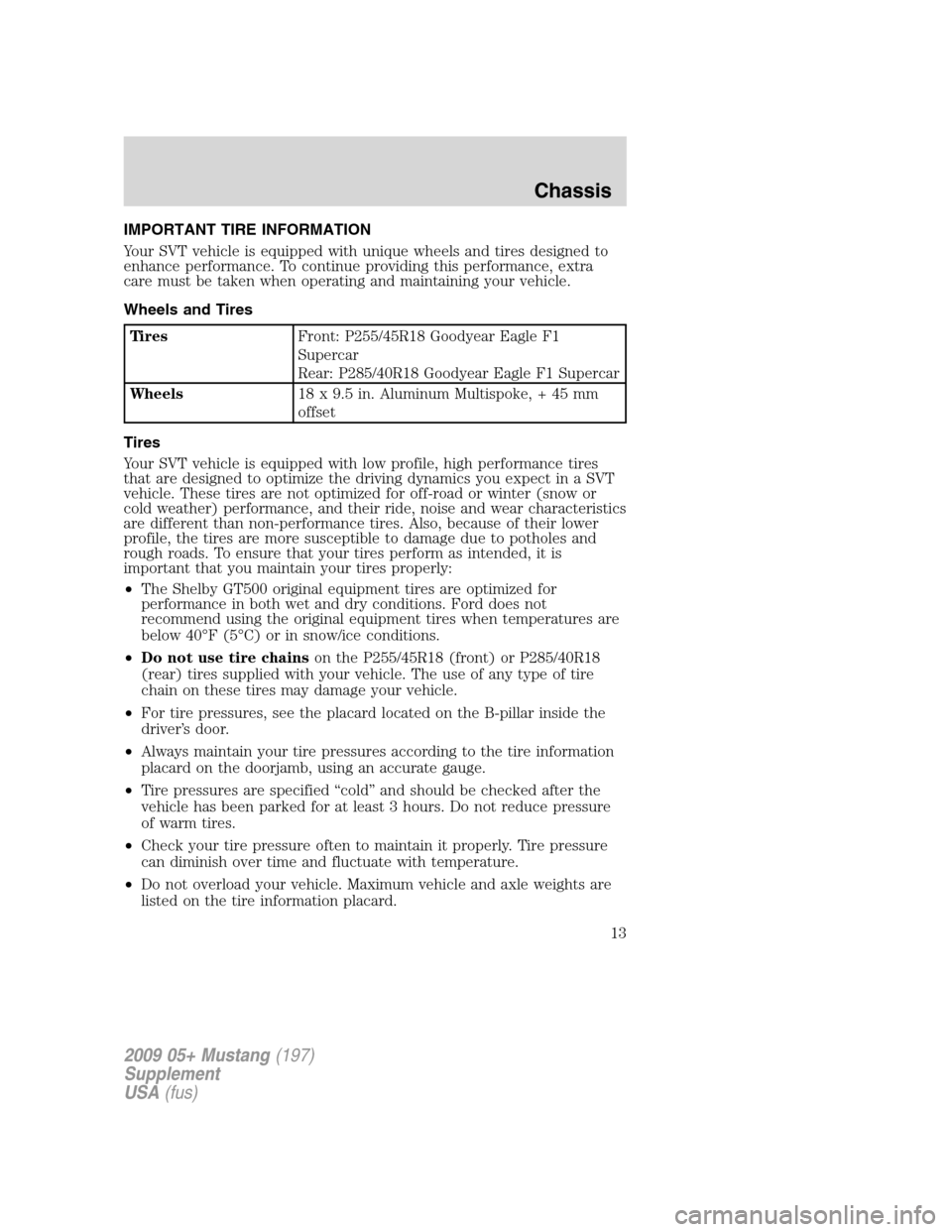
IMPORTANT TIRE INFORMATION
Your SVT vehicle is equipped with unique wheels and tires designed to
enhance performance. To continue providing this performance, extra
care must be taken when operating and maintaining your vehicle.
Wheels and Tires
TiresFront: P255/45R18 Goodyear Eagle F1
Supercar
Rear: P285/40R18 Goodyear Eagle F1 Supercar
Wheels18 x 9.5 in. Aluminum Multispoke, + 45 mm
offset
Tires
Your SVT vehicle is equipped with low profile, high performance tires
that are designed to optimize the driving dynamics you expect in a SVT
vehicle. These tires are not optimized for off-road or winter (snow or
cold weather) performance, and their ride, noise and wear characteristics
are different than non-performance tires. Also, because of their lower
profile, the tires are more susceptible to damage due to potholes and
rough roads. To ensure that your tires perform as intended, it is
important that you maintain your tires properly:
•The Shelby GT500 original equipment tires are optimized for
performance in both wet and dry conditions. Ford does not
recommend using the original equipment tires when temperatures are
below 40°F (5°C) or in snow/ice conditions.
•Do not use tire chainson the P255/45R18 (front) or P285/40R18
(rear) tires supplied with your vehicle. The use of any type of tire
chain on these tires may damage your vehicle.
•For tire pressures, see the placard located on the B-pillar inside the
driver’s door.
•Always maintain your tire pressures according to the tire information
placard on the doorjamb, using an accurate gauge.
•Tire pressures are specified “cold” and should be checked after the
vehicle has been parked for at least 3 hours. Do not reduce pressure
of warm tires.
•Check your tire pressure often to maintain it properly. Tire pressure
can diminish over time and fluctuate with temperature.
•Do not overload your vehicle. Maximum vehicle and axle weights are
listed on the tire information placard.
2009 05+ Mustang(197)
Supplement
USA(fus)
Chassis
13
Page 14 of 33

•Extra caution should be taken when operating the vehicle near its
maximum load, including assuring proper tire pressure and reducing
speeds.
•Extra caution should be taken when operating on rough roads to avoid
impacts that could cause tire damage.
•In the event that you encounter an abnormally harsh impact, inspect
your tires for damage.
•Inspect your tires for damage on a regular basis. If a tire is damaged,
replace it immediately.
•Proper suspension alignment is critical for maximum performance and
optimal tire wear. If you notice uneven tire wear, have your alignment
checked.
•Rotate tires as recommended in the following sectionTire rotation.
•When replacing tires, the only way to assure original performance is to
use the original equipment tire. If a different tire is used, it should be
the same size, speed rating and load rating and be replaced as a set of
four. Never mix tire brands.
Winter driving
The original equipment tires on your SVT vehicle are designed for
maximum performance in dry and wet summer conditions. They are not
designed for winter use on ice or snow and cannot be used with snow
chains. If you will be operating your vehicle in these conditions, winter
or all-season tires must be used.
•Use winter tires on all four wheels and use P255/45R18 tires with a
“V” speed rating and a 93 load index or higher.
•Winter tires must be of the proper speed and load ratings.
•Be aware that winter or all-season tires will not perform as well as the
original equipment tire in dry and wet conditions. Expect handling,
steering and braking to be degraded.
•Do not use a winter tire with less than a “V” speed rating, and even
with clear, dry driving conditions do not operate your vehicle above
posted speed limits while using winter tires. Never perform high speed
driving with winter tires.
2009 05+ Mustang(197)
Supplement
USA(fus)
Chassis
14
Page 15 of 33
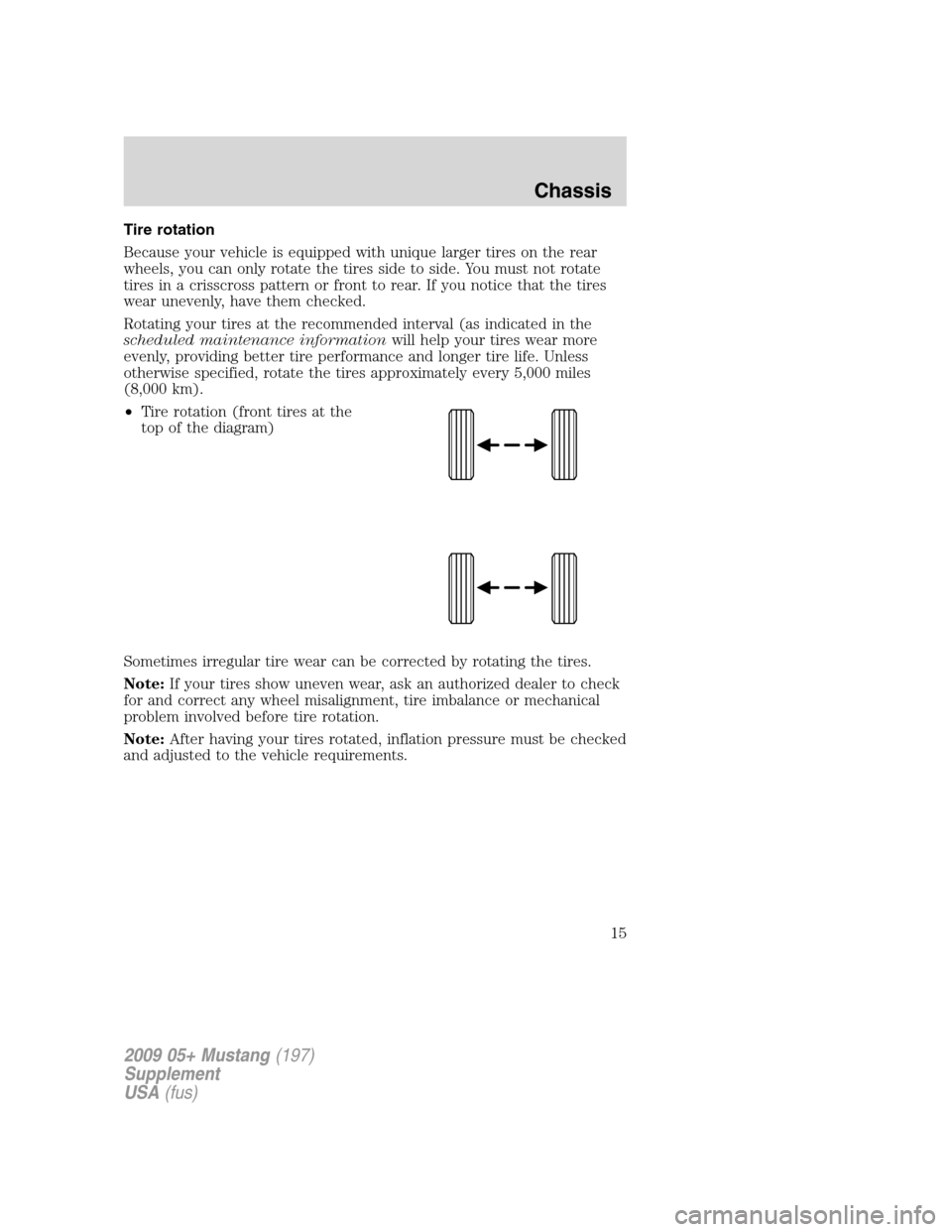
Tire rotation
Because your vehicle is equipped with unique larger tires on the rear
wheels, you can only rotate the tires side to side. You must not rotate
tires in a crisscross pattern or front to rear. If you notice that the tires
wear unevenly, have them checked.
Rotating your tires at the recommended interval (as indicated in the
scheduled maintenance informationwill help your tires wear more
evenly, providing better tire performance and longer tire life. Unless
otherwise specified, rotate the tires approximately every 5,000 miles
(8,000 km).
•Tire rotation (front tires at the
top of the diagram)
Sometimes irregular tire wear can be corrected by rotating the tires.
Note:If your tires show uneven wear, ask an authorized dealer to check
for and correct any wheel misalignment, tire imbalance or mechanical
problem involved before tire rotation.
Note:After having your tires rotated, inflation pressure must be checked
and adjusted to the vehicle requirements.
2009 05+ Mustang(197)
Supplement
USA(fus)
Chassis
15
Page 25 of 33
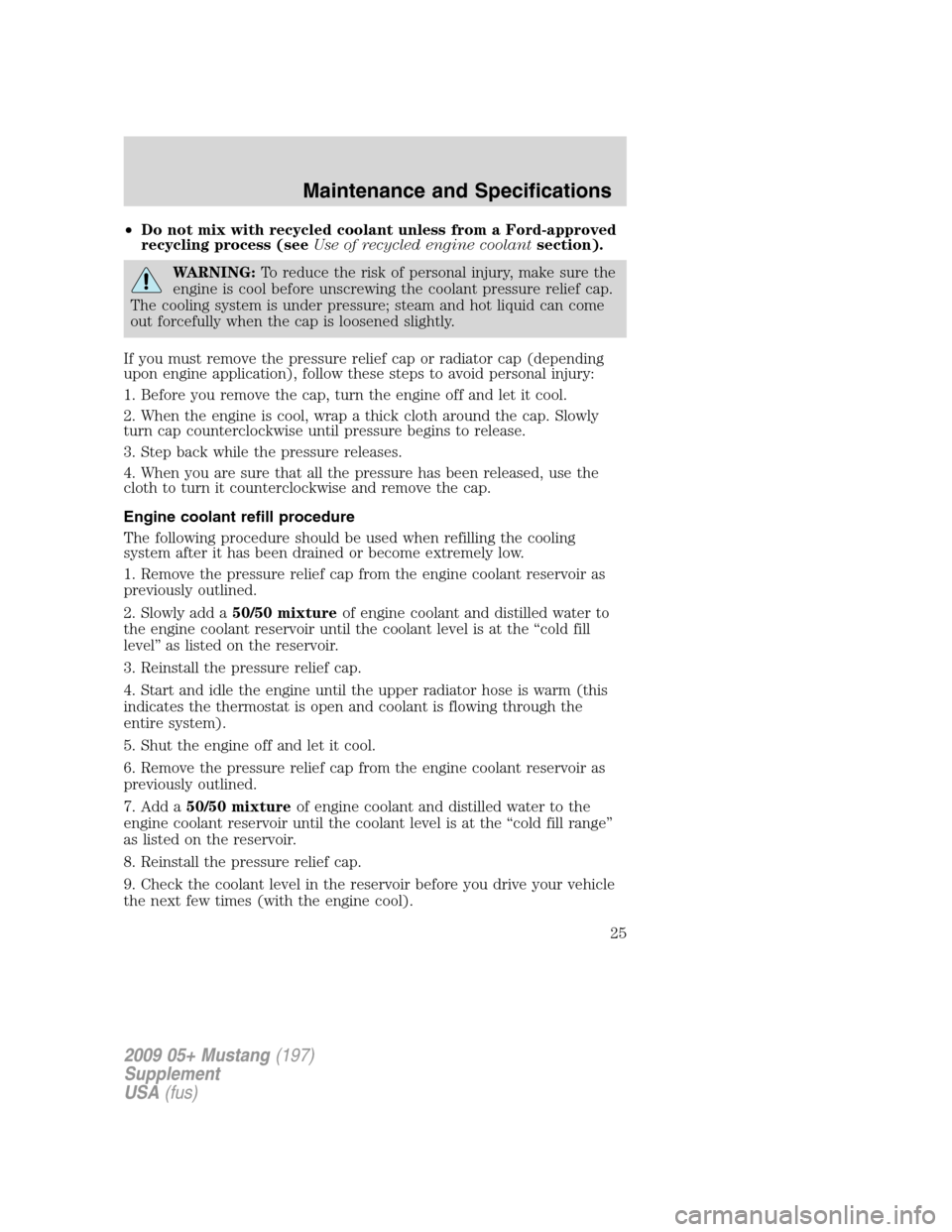
•Do not mix with recycled coolant unless from a Ford-approved
recycling process (seeUse of recycled engine coolantsection).
WARNING:To reduce the risk of personal injury, make sure the
engine is cool before unscrewing the coolant pressure relief cap.
The cooling system is under pressure; steam and hot liquid can come
out forcefully when the cap is loosened slightly.
If you must remove the pressure relief cap or radiator cap (depending
upon engine application), follow these steps to avoid personal injury:
1. Before you remove the cap, turn the engine off and let it cool.
2. When the engine is cool, wrap a thick cloth around the cap. Slowly
turn cap counterclockwise until pressure begins to release.
3. Step back while the pressure releases.
4. When you are sure that all the pressure has been released, use the
cloth to turn it counterclockwise and remove the cap.
Engine coolant refill procedure
The following procedure should be used when refilling the cooling
system after it has been drained or become extremely low.
1. Remove the pressure relief cap from the engine coolant reservoir as
previously outlined.
2. Slowly add a50/50 mixtureof engine coolant and distilled water to
the engine coolant reservoir until the coolant level is at the “cold fill
level” as listed on the reservoir.
3. Reinstall the pressure relief cap.
4. Start and idle the engine until the upper radiator hose is warm (this
indicates the thermostat is open and coolant is flowing through the
entire system).
5. Shut the engine off and let it cool.
6. Remove the pressure relief cap from the engine coolant reservoir as
previously outlined.
7. Add a50/50 mixtureof engine coolant and distilled water to the
engine coolant reservoir until the coolant level is at the “cold fill range”
as listed on the reservoir.
8. Reinstall the pressure relief cap.
9. Check the coolant level in the reservoir before you drive your vehicle
the next few times (with the engine cool).
2009 05+ Mustang(197)
Supplement
USA(fus)
Maintenance and Specifications
25